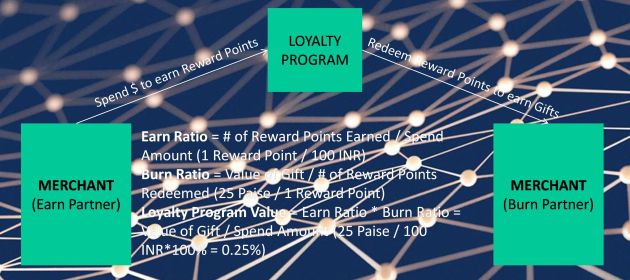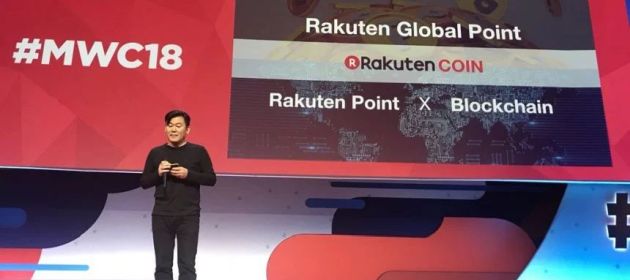Loyalty programs give reward points to consumers for making purchases and let consumers redeem their reward points for gifts. By their very nature, reward points look like an alternative currency and quack like an alternative currency.
Blockchain lets them pass the Duck Test and become a alternative currency aka alt-coin.
I’ve heard of platforms that help brands build their loyalty programs on the blockchain. But I’ve come across only one loyalty program itself that’s already on the blockchain: Rakuten Coin.
Japan’s largest retailer recently announced a blockchain-based loyalty program on which reward points will be issued in the form of an alt-coin called Rakuten Coin. According to CoinDesk, Rakuten has moved US$ 9 billion worth of existing Super Points into the blockchain to give a fillip to Rakuten Coin.
Let’s see how blockchain will help drive repeat purchase, which is the primary goal of a loyalty program.
Loyalty programs have a powerful value proposition because they offer rewards for spends anyway made by consumer. As a result, they’ve become very popular. According to reports, an average American is a member of seven loyalty programs, with some of them having as many as 15 loyalty cards in their wallet. I couldn’t find equivalent figures for the rest of the world but it’s safe to say that loyalty programs are dime a dozen in all countries.
88%, 57%, 84% – three numbers that clearly establish how loyalty programs can boost revenues, profits and C-SAT. http://t.co/Dwcq0NjROh
— GTM360 (@GTM360) April 7, 2014
In theory, loyalty programs drive repeat purchase of a brand because they give reward points for buying that brand (but not competing brands).
In practice, however, their efficacy has been mixed.
Amazon Prime is widely hailed as the greatest driver of Amazon’s success. So are the frequent flyer programs of most airlines and loyalty programs of many credit cards.
On the other hand, Walmart (worldwide), Apple (USA), DMART (India) and Indigo Airlines (India) are examples of a few brands that have done very well without running a loyalty program.
What gives?
Enter “too many loyalty programs, too few reward points”.
IMO, this notorious problem is responsible for the mixed performance of loyalty programs (Irrelevance of gifts is another problem but, since it’s comparatively rarer, I’ll ignore it in the present context.)
If you notice a striking resemblance between this problem statement and the “so much to do, so little time” problem of Joker in Batman movies, it’s not coincidental.
I’ll illustrate this problem by taking the example of Joe Consumer. At the start of a year, Joe joins loyalty programs from three merchants, namely, Red Loyalty Program, Green Loyalty Program and Blue Loyalty Program.
Like any typical loyalty program, these programs work in the following manner:
- Joe gets Red Points when he shops at Red Merchant but not when he shops at other merchants; likewise with Green and Blue points.
- Red Points can be redeemed for gifts only under Red Loyalty Program; ditto Green and Blue Points. In other words, Red Points cannot be redeemed under Green or Blue Loyalty Programs
- Red Program requires a minimum of 300 Red Points for redemption; Green Program requires 500 Green Points; and Blue Program requires 100 Blue Points
- All reward points expire in one year
During the course of the year, Joe earns 100 Red Points, 200 Green Points and 50 Blue Points by shopping at Red, Green and Blue merchants respectively.
At the end of the year, Joe’s tally of reward points – 100, 200 and 50 – falls short of the qualifying limit under the respective program. As a result, he can’t redeem any of his points. Joe doesn’t get any gifts. Worse still, all his points lapse.
Joe starts from a blank slate next year and concludes, rightly, that he got nothing for being loyal to the three brands last year, so why bother being loyal to them this year.
Feh on @ihgrewardsclub for expiring points. Totally goes against USP of lifetime validity touted by its predecessor PRIORITY CLUB. pic.twitter.com/5y9Lxv8gZ6
— GTM360 (@GTM360) April 2, 2017
Over time, the “too many programs, too few points” problem dampens consumer enthusiasm. Consumers start making future purchase decisions on the basis of price, discounts and other factors – exactly the kind of behavior meant to be curbed by loyalty programs.
To revive flagging interest in loyalty programs, brands and third party loyalty program providers have attempted a few tactics over the years. Chief among them are the following:
 Coalition Loyalty: Payback (Germany, India) and Nectar (UK) are two leading coalition loyalty programs that let consumers earn reward points by making purchases from multiple merchants (Earn Partners) and redeem them for gifts at multiple merchants (Burn Partners). To that extent, they widen the network of merchants where consumers can earn and burn points and thereby provide a better chance to consumers to redeem their reward points before they lapse.
Coalition Loyalty: Payback (Germany, India) and Nectar (UK) are two leading coalition loyalty programs that let consumers earn reward points by making purchases from multiple merchants (Earn Partners) and redeem them for gifts at multiple merchants (Burn Partners). To that extent, they widen the network of merchants where consumers can earn and burn points and thereby provide a better chance to consumers to redeem their reward points before they lapse.
 Reward Exchanges: Here consumers can trade reward points across loyalty programs. Suppose our friend Joe has no use for his 50 Blue Points. Now let’s assume that there’s a Jane who who has 100 Green Points for which she has no use but can use Blue Points of which she has none. The Reward Exchange helps Joe and Jane connect with each and trade Joe’s 50 Blue Points for Jane’s 100 Green Points. At the end of the trade, Joe’s tally will be 100 Red Points, 300 Green Points (0 Blue Points) and Jane’s tally will be 50 Blue Points (0 Red Points and 0 Green Points). (This can happen when Green is grocery points and Blue is airline points and Joe is not planning to travel whereas Jane is relocating to another city where the grocery store does not have a presence).
Reward Exchanges: Here consumers can trade reward points across loyalty programs. Suppose our friend Joe has no use for his 50 Blue Points. Now let’s assume that there’s a Jane who who has 100 Green Points for which she has no use but can use Blue Points of which she has none. The Reward Exchange helps Joe and Jane connect with each and trade Joe’s 50 Blue Points for Jane’s 100 Green Points. At the end of the trade, Joe’s tally will be 100 Red Points, 300 Green Points (0 Blue Points) and Jane’s tally will be 50 Blue Points (0 Red Points and 0 Green Points). (This can happen when Green is grocery points and Blue is airline points and Joe is not planning to travel whereas Jane is relocating to another city where the grocery store does not have a presence).
(Reward exchanges should not be confused with loyalty consolidators like Using Miles and KeyRing. The latter merely help consumers manage multiple loyalty programs from a single portal / app, but they don’t support trading of points across programs. So, if points lapse before they’ve reached a level where they can be redeemed for something meaningful, tough luck – the only good news being you’ll get the bad news that your points have lapsed on all loyalty programs on a single portal / via single email from the loyalty consolidator.)
But these tactics have had limited success because of the following reasons:
- Coalition loyalty programs still permit points to be redeemed only within the program under which they’re earned. So, Red Points in the above example can still be redeemed only under the Red Loyalty Program and, if Joe doesn’t have enough of them, he loses them at the end of the year. Besides, coalition programs operate under one major constraint: They can accept only one Earn / Burn Partner per product category – or at least this is what I was told when Payback let go its existing fashion partner Big Megamart (now UNLIMITED) in India when it signed up the bigger fashion brand Fashion Big Bazaar (FBB). As a result, liquidity – industry speak for stores where reward points can be redeemed – is restricted to one brand / merchant per product category.
- While there has been a lot of buzz around reward exchanges over the years, I haven’t come across a single exchange that’s actually operational. That’s probably because of “breakage”, the term used in the loyalty industry to refer to reward points that are not redeemed. As industry insiders know, breakage can be as high as 30%. It’s open secret in the industry that breakage is baked into the business model of loyalty programs. So, consumers trying to trade reward points in one loyalty program for another will find themselves getting disproportionately lower number of reward points from the other program. When they learn this bitter truth, many consumers prefer to hold on to their original reward points instead of trading them at a discount. This severely undermines the utility of reward exchanges even though they sound great in theory.
So, despite decades of attempts to solve it, the “too many programs, too few points” problem hasn’t gone away and the performance of loyalty programs remains lacklustre.
Blockchain can provide a huge shot in the arm to loyalty programs and raise their performance to the next level.

Key Metrics of a Loyalty Program
Earn Ratio = # of Reward Points Earned / Spend Amount (1 Reward Point / 100 INR)
Burn Ratio = Value of Gift / # of Reward Points Redeemed (25 Paise / 1 Reward Point)
Loyalty Program Value = Earn Ratio * Burn Ratio = Value of Gift / Spend Amount (25 Paise / 100 INR*100% = 0.25%)
Let’s see how, by using Rakuten’s blockchain loyalty program as an example.
By objectifying all rewards to a single branded token – Rakuten Coin – Rakuten immediately solves the problem of fragmentation of reward points across different loyalty programs. In other words, Joe can blend his three types of points into a single store of value i.e. Rakuten Coin.
Coming to redemption, it’s a no-brainer that Rakuten Coin should be redeemable for gifts at all Rakuten Group companies.
But that’s not enough – stopping there would merely amount to applying the blockchain lipstick on traditional coalition loyalty programs.
Ideally, Rakuten Coin should be accepted universally. But, in the real world, it’s virtually impossible for Rakuten to negotiate with each and every non-Rakuten merchant in the world – or even Japan – to accept Rakuten Coin.
Fortunately, it doesn’t need to. This is where the other benefit of “blockchaining” a loyalty program comes in.
Blockchain offers more than just the ability to convert reward points to an alt-coin.
As MIT Technology Review explains in Let’s Destroy Bitcoin: “These tokens are not unlike the points systems and gift cards that companies have used to hem in their customers for decades. What changes when you record these assets on a blockchain is that they become easily and securely transferable.”
Blockchain also allows Rakuten to list Rakuten Coin on leading cryptoexchanges. This will have two benefits:
Unlimited liquidity. Consumers will be able to freely trade their Rakuten Coins for Bitcoin and other cryptocurrencies that are already accepted by tens of thousands of merchants (many of whom may not even have heard of Rakuten). The question of where Rakuten Coins can be redeemed now becomes moot – it can be converted to cash or cash equivalent virtually everywhere. This will also solve the problem of not having enough reward points to qualify for the minmum limit set by conventional loyalty programs to redeem them because most exchanges don’t have a minimum trading lot size these days.
Buoyancy. Cryptoexchange listing will inject buoyancy into Rakuten Coin, even if the added lift is largely speculative in nature at this point. When Joe finds that his $100 worth of Green Points gets him only $70 worth of Blue Points, he’s bound to have a misgiving. But, if he gets the same value in a cryptocurrency, the crypto’s buoyancy will counter that misgiving. It’s human nature to rationalize today’s deficit as an investment if there’s a chance of earning multibagger returns on it in future. (Ditto corporate nature, going by Aswath Damodaran’s take on the premium paid by Walmart for Flipkart. Writing in Economic Times, the Professor of Finance, Stern School of Business, New York University, observes, “where you have hundreds of billions of dollars in play, a multibillion premium paid on an acquisition is penny change.”) From my back-of-the-envelope calculations, 1 trillion Super Points have been converted to Rakuten Coin worth $9.1 billion. This translates to a Burn Ratio of $9.1B/1T Points i.e. 0.0091 $ / Point, or almost 1 cent per point. This is 2.5X of Payback’s burn ratio of 0.4 cents per point (being $ equivalent of 0.25 INR / Point). So Rakuten Coin is already exhibiting buoyancy.
This is how Blockchain can help Rakuten – and other brands – to crack the Holy Grail of loyalty programs.
By harnessing the full capabilities of the blockchain, loyalty programs can delight consumers.
That should be benefit enough for brands to embrace the blockchain for their loyalty programs.
UPDATE DATED 20 FEBRUARY 2022:
 I’ve been asked many times to write about my take on the latest status of the aforementioned Rakuten Coin.
I’ve been asked many times to write about my take on the latest status of the aforementioned Rakuten Coin.
That is not strictly true. I’ve been asked only once, by @droskill on Twitter.
(Fans of Joseph Heller might find a striking resemblance between the above paragraphs and the opening paragraphs of Good As Gold, one of my all time favorite novels. I apologize in advance to the Estate of Heller for taking the liberty of paraphrasing what’s one of the most captivating novel starts that I’ve ever read.)
I did some quick-and-dirty research and this is what I found:
- There’s no mention of Rakuten Coin anywhere, at least not in English language websites. I didn’t review the entries in Japanese.
- There’s mention of Rakuten Pay, Rakuten Points, Rakuten Cash, and Rakuten Point Card. Cf. Coindesk article entitled E-Commerce Giant Rakuten Now Lets Users Shop With Cryptocurrency and Rakuten.Today blog post entitled Rakuten Points: Much more than just a loyalty program.
- According to the Rakuten.Today blog post: “Since 2017, crypto asset management service Rakuten Wallet has allowed users to buy and sell cryptocurrencies such as Bitcoin and Ethereum, conveniently exchanging them to and from Japanese yen. But yen isn’t your only ticket to ride the cryptocurrency train: Rakuten Wallet users can also use their Rakuten Points to top up their portfolio. The service sweetened the deal even further, introducing a new way for users to convert their assets back into a spendable currency. For no cost, users can now turn their Bitcoin and Ethereum into Rakuten Cash — tied to the Japanese yen and functionally similar to Rakuten Points” (emphasis mine.)
I have no inside track into this but I’m guessing that Rakuten did not mint any alt-coin (Rakuten Coin) from its loyalty points (Rakuten Points). But, by permitting consumers to convert Rakuten Points to cryptocurrencies and cryptocurrencies back to Rakuten Cash, the Japanese conglomerate has achieved both the benefits of a blockchain loyalty program mentioned in the original post, namely, “Unlimited liquidy” and “Buoyancy”. So, in effect, Rakuten seems to be running a blockchain loyalty program.
Also, as tracked in the comments below, a few other players have entered the blockchain loyalty space in the four years since I published the original post e.g. Bakkt.
DISCLAIMER: The Blockchain world has an eclectic mix of elements like cryptocoin, ICO, and so on whose legal status is ambiguous and swings wildly between various states of the spectrum such as illegal, maybe-illegal, not-illegal and legal and from one country to another. Before following through with the guidance given in this post, please consult your legal counsel about their legal status in your respective jurisdiction. We offer no guarantees as to legality of any of the guidance provided in this post.


